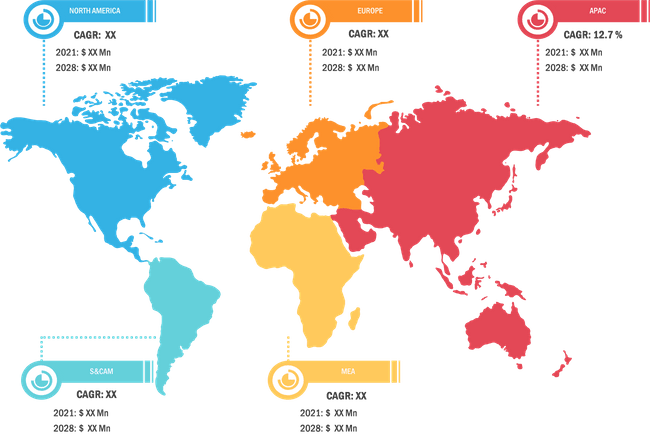Long-acting Insulin Segment to Hold Major Insulin Market Share During 2022–2028
According to our new research study on "Insulin Market Forecast to 2028 – COVID-19 Impact and Global Analysis – by Type, the market was valued at US$ US$ 1,11,213.73 million by 2028 from US$ 60,183.09 million in 2022; it is estimated to grow with a CAGR of 10.8% from 2022-2028. The report highlights the trends and drivers prevailing in the Insulin market.
Based on type, the insulin market is segmented into long-acting insulin, rapid acting insulins, short acting insulins and traditional human insulins, concentrated insulins and combination insulins, biosimilar insulins, Glucagon-like peptide-1 (GLP-1), pens and needles, and others. The long-acting insulin segment is anticipated to hold the largest market share in 2021 and however, biosimilar insulins segment is expected to register the highest CAGR of 16.0 % during the forecast period. The major driving factors for the growth of the biosimilar insulins segment are increasing applications of inbred mice in cardiovascular & immunology studies and the production of monoclonal antibodies, among others. Biosimilar insulin is a biological copy of the original insulin, and there is increasing interest in its development and use. Biosimilar insulins are cheaper than genuine products, so they offer the NHS opportunities regarding availability and cost of care. Biosimilar insulins are manufactured in living organisms (e.g., yeast and bacteria) to produce large quantities of the desired high-protein product, limiting the ability to create replicas of original biological drugs. There are currently 11 biosimilar products approved in the United States, none of which are yet considered interchangeable with their originator product. Some concerns related to biosimilar insulins include potential differences in efficacy and safety between a biosimilar product and its reference insulin, the implications of having the same name or different names for a biosimilar and its reference insulin, the prospects and limitations of insulin product substitution, and the proper implementation of pharmacovigilance.
Insulin Market Forecast to 2028 - COVID-19 Impact and Global Analysis by Type (Long Acting Insulin, Rapid Acting Insulins, Short acting Insulins and Traditional Human Insulins, Concentrated Insulins and Combination Insulins, Biosimilar Insulins, Glucagon-like peptide-1 (GLP-1), Pens and Needles, and Others), and Geography
Insulin Market Trends and Scope by 2028
Download Free Sample
Impact of COVID-19 Pandemic on Insulin Market
The COVID-19 pandemic had impacted diabetes treatment in a pervasive manner. The sudden situation has stimulated cardio-diabetic professionals, healthcare decision-makers, and policymakers, who have met with the need to expeditiously implement containment measures to mitigate the impact of the COVID-19 pandemic. Moreover, according to the Department of Emergency Medicine, in many cities across the country, emergency department (ED) visits decreased by ~40% in 2020. Moreover, outpatient appointments and elective treatments were postponed or replaced by telemedicine practices. The Centers for Disease Control and Prevention (CDC) in the U.S conducted research showing that 40% or more of the people who died from COVID-19 also had diabetes. Deaths from diabetes surged 17% to more than 100,000, in 2020 based on a Reuters analysis of CDC data. Younger people aged 25 to 44, suffered a keen increase, with a 29% hop in deaths. All other deaths except those directly ascribed to the coronavirus rose 6% last year, the survey found.
After Asia, the European region was highly contrived by the outbreak of COVID-19. The countries like Italy, Spain, the UK, Germany, France, and other European counties such as Russia, and Switzerland were highly affected. The mean prevalence of diabetes in Europe in people affected by COVID-19 has been reported to be 33% by the WHO Europe. Italy was the first country in the region to be contrived by the pandemic. The situation in the north of the country was dramatic while in the southern area it remained under control. The second country showing a similar trend was Spain; the epidemic was very serious in the areas of Madrid and Barcelona and less so in other parts. Italy and Spain adopted the “lockdown” strategy quite quickly, closing almost all activities and keeping their citizens at home. This lockdown was also rapidly adopted in several other countries. Moreover, the shift of priorities from diabetes treatment to coronavirus diagnosis and treatment devices were leading to a moderate decline in insulin demand, leading to a decrease in market growth up to the certain extent.
Eli Lily and Company; Novo NordiskA/S; Biocon; Wockhardt; Adocia; GlaxoSmithKline plc; Sanofi; Pfizer; Merck &Co., Inc.; Tonghua Dongbao Pharmaceutical Co., Ltd.; and Bigfoot Biomedical, Inc. are a few of the key companies operating in the insulin market.
Recent Developments:
Inorganic and organic strategies such as mergers and acquisitions are highly adopted by companies in the insulin market. A few recent key market developments are listed below:
- In Nov 2021, Viatris launched a non-interchangeable Semglee in 2020 at a WAC price of $99, marking a steep discount off Lantus' WAC of $284.
- In Jan 2022, Merck announced an extension to the label for metformin products in EU such as Glucophage, Glucophage XR, and Stagid for use throughout the pregnancy.
Contact Us
Phone: +1-646-491-9876
Email Id: sales@theinsightpartners.com